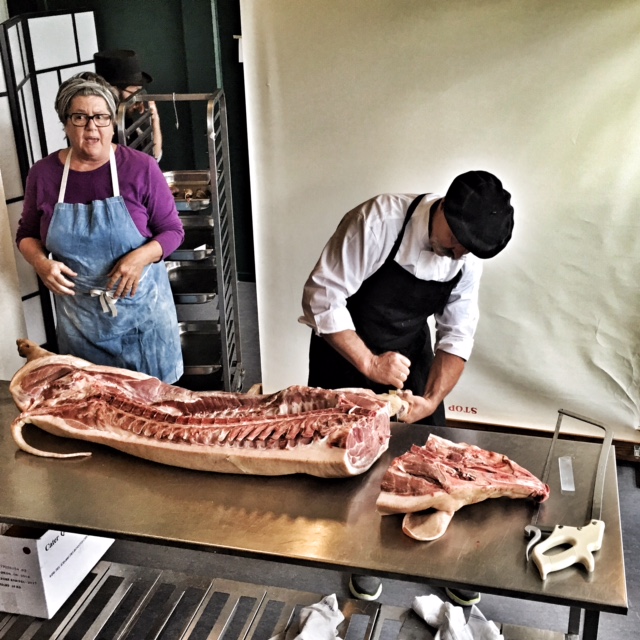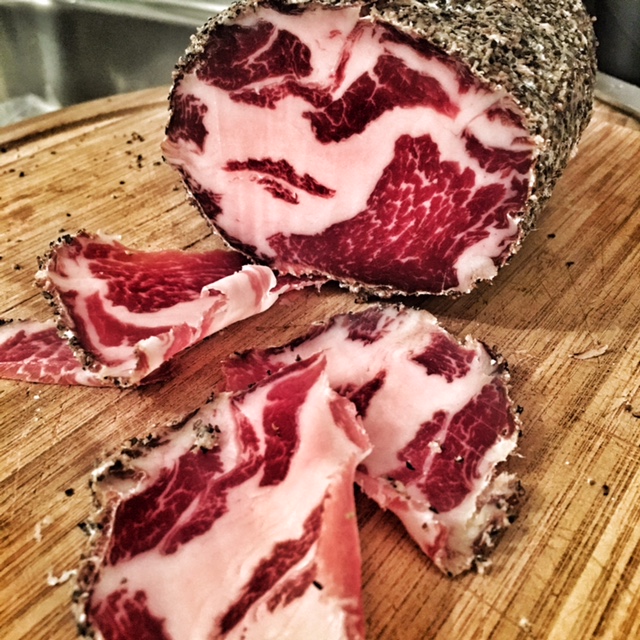Copenhagen is an expensive town. The Butchers’ Manifesto week did some real damage to my wallet.
Trying to keep up with the butchers and chefs and their penchant for fine-dining, left this student financially strapped. Luckily, Michael Museth opened a door and offered me an opportunity to work for him at Folkets Madhus. Remember, Folkets Madhus (People's Food House in Danish) is a catering house and butcher shop. I would be assisting Michael with his catering events and meat experimentations.
A new adventure in meat means a new adventure in accommodations. The staff at Folkets Madhus lost their conference room to me, my small wooden frame, and mattress. It wasn't bad, my new sleeping quarters had a killer view of the garden and bomb shelter, and after a couple of nights, it felt like home.
My Danish digs.
Showering, on the other hand, was a different ordeal. Folkets Madhus didn’t have shower facilities - after all, they are a butcher shop. However, the city of Copenhagen rented the floor below the shop and used it as a locker room for their sanitation workers. The first few times I tried to shower there, I got chased out by garbage men shouting obscenities in Danish. The only chance to use these facilities verbally unscathed was when it was unoccupied: between the hours of 1-4am.
Did I mention the lights were usually working on a timer?
Yeah, I showered in the dark a lot.
My shower facilities.
One of the reasons Michael asked me to stay back in Copenhagen was to assist him with some approaching catering events. In just three days, he was expected to feed 175 people at a food festival in Copenhagen's meatpacking district. While Michael recouped from the Butchers’ Manifesto, I dove into the kitchen and began prepping for our first event.
On the morning of the event, Michael assigned tasks. We started with the most exotic ingredients first – wheat worms and crickets. Neo-Nordic cuisine integrates insects into the food – something I was not familiar with.
Frozen organic wheat worms.
Michael got the worms and bugs smoking in an outdoor shed he had converted into a makeshift oven. While they smoked, I watched them from the kitchen window as I peeled 50 kilos of potatoes. After a half hour into the potato peeling, I glanced out the window – puffs of smoke gingerly curled out of the shed’s exhaust pipes, signaling what I thought was a good smokin’. Another 15 minutes, and this time I saw large clouds of smoke billowing out the pipes.
“Fire- Fire!”
We scrambled down the stairway and out to the shed. Flames leaped as we opened the shed doors. After extinguishing eight fire extinguishers, the fire calmed enough to make easy work for the local fire department once they arrived.
Gustav and Jonas sprang into action and went through 7 fire extinguishers before the Copenhagen Fire Department showed up.
While we were being checked out by the medical crew for smoke inhalation, the professionals extinguished the last of the flames.
In total, our fire brought over three firetrucks and an ambulance.
Those Danish firefighters sure got a kick out of us smoking bugs!
It was this firefighter's last fight - he was retiring the following day, so he ask for pictures with one of the worms - before jokingly gesturing he was going to swallow the burnt one.
The outcome of the catering event?
Michael quickly procured another batch of bugs. Gustav, a fellow butcher, and I began built a new smoke oven, and a few hours later, we rolled into the Meat Packing District with a car loaded down with Neo-Nordic cuisine.
Views from the Food Festival in the Meatpacking District. This table stretched on for what seemed like three quarters of a mile. Each caterer was assigned a 12 table section so there was a ton of kitchen staff running around!
Michael Museth and I with our "Smoked Honey Bug Salad." Those smoked wheat worms and crickets turned out to be pretty good. I will forever be indebted to Michael for the opportunity he gave me in Denmark.











































